Soybeans
The common cultivated soybean is botanically classified as Glycine max L. and is a member of the subgenus soja, genus Glycine and the family Fabaceae. Soybean is not a true pulse crop. This subgenus contains only one other species, Glycine soja L., which is the wild ancestor of Glycine max.
Soybeans are grown and marketed for both human and animal consumption as a source of protein and oil. Soybeans are used for both fermented and unfermented products; as an ingredient for many meat and dairy substitutes; and a fat-free (defatted) soybean meal is a significant source of protein for animal feeds.
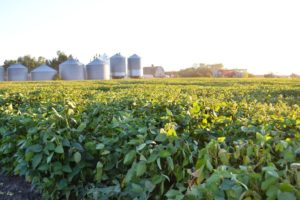
Where do soybeans grow?
While the cultivated form, Glycine max, has never been found in the wild, Glycine soja is found throughout China and the adjacent areas of the Russia, Korea, Japan and Taiwan. Soybeans have been cultivated in Asian civilizations for thousands of years, and are one of the most important food crops globally today.
As of 2019, the top five producing countries of soybean are the United States (108 Million metric tonnes (MMT), Brazil (86.8), Argentina (53.4), China (12.2), and India (10.5). Canada is #7 with 6 Million metric tonnes. Source: World Atlas, https://www.worldatlas.com/articles/world-leaders-in-soya-soybean-production-by-country.html
Main importers are the European Economic Community, Japan, Spain and Eastern Europe.
In 2019, Alberta’s pulse growers grew 4,900 metric tonnes of soybeans on 6,500 acres. Statistics were not available for farm cash receipts or export values.
(Source: Alberta Agriculture and Forestry, Economics and Competitiveness Branch)
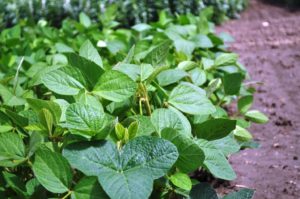
Consider growing soybeans if…
- You live in Southern Alberta under irrigation, and get the needed crop heat units (CHU).
- You’re looking for a warm weather crop that likes lots of moisture.
- You’re growing in the brown and dark brown soil zones of Alberta.
- You want to spread out your workload with early seeding and harvest.
- You’re interested in marketing flexibility that includes markets for both human consumption (including fractionation) and animal feed.
- You are looking for a pulse option that is resistant to several root diseases.
- You want to reduce your input costs (as pulses are nitrogen fixing); break disease cycles in your field; obtain a second-year yield boost in other crops following a pulse crop; improve your soil health; promote soil conversation and sustainable farming practices; and improve farm profitability.
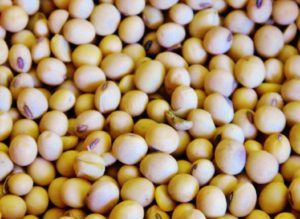
Figure 3: Soybeans
Description
Soybeans are an annual legume plant with a branched tap root. Soybeans are a dicot crop and exhibit epigeal germination – during the vegetative stage, the cotyledons and the growing point push up above ground and are the first above-ground structures. The size of the cotyledons on the soybean are quite large, so crusted hard soils can impede emergence. Germination occurs within three to four days at an air temperature of 25˚ to 30˚C.
Soybeans are sensitive to day length in their growth and reproduction. Soybeans have two common growth habits, determinate and indeterminate. There is a preference for determinate soybean varieties in Alberta and virtually all soybean grown south of 36˚N plus most tropical soybeans are determinate.
Leaf Structures
The first true leaves of the soybean plant are unifoliate, and opposite of the stem on short petioles. All other true leaves following are trifoliate on long petioles and alternate from side to side up the steam. The number of trifoliate leaves that a soybean will have will fluctuate with variety and environmental conditions. New vegetative stages appear about every five days from VC (Vegetative Stage Cotyledon) when the plant unrolls its unifoliate leaves, through to VC5 (Vegetative Stage 5), where the first five nodes (growing points) on the main stem with fully developed leaves beginning with the unifoliolate nodes. Then every three days from V5 to shortly after R5 (Reproductive 5), where the seeds are 1/8 inch in the pod at one of the four uppermost nodes on the main stem with a fully developed leaf. This is the maximum number of nodes, however the seed begins to rapidly fill, and the root growth slows. It will take the plant approximately four to five weeks to form all nodes. See “Soybean Growth Staging Guide” and other links in resource section below.
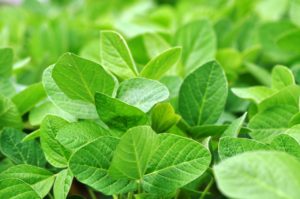
Reproductive nodes (flower)
Soybean is almost completely self-pollinated. As the days begin to shorten, flowering is initiated in the crop. Growth stages are heavily influenced by heat, and increased mean temperatures will hasten flowering. Reduced mean temperatures will delay flowering, in relation to photoperiod length – which is the period of time each day during which the plant receives illumination (day length). Flowering will begin within 25 to 50 days of planting, or even later (depending on cultivars and environmental conditions).
Determinate types produce flowers at all nodes over a short period, and each terminal bud forms a distinct raceme. Raceme are an inflorescence in which the main stock bears the flowers on stalks (pedicels), appearing as a dense cluster of lateral flowers growing from any node on the main stem, to flowers at one of the two uppermost nodes on the main stem with a fully developed leaf.
Determinate cultivars are usually shorter and more branched than the indeterminate ones. Indeterminate types begin to flower at lower nodes while terminal buds continue to grow vegetatively. Flowering normally begins at the fourth or fifth node above the soil surface and proceeds at successive nodes above and below this node. Terminal buds eventually turn reproductive and flower, with fruits first forming close to the base of the plants.
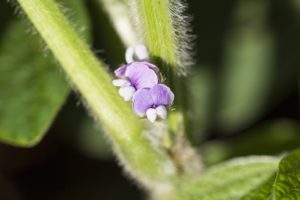
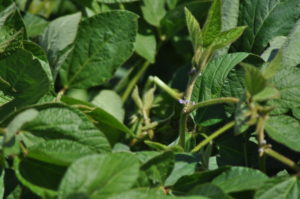
Soybean Pods
The fruit is a hairy pod that grows in clusters of three to five, and each pod is 3 – 8 cm (1.2 – 3.1 in) long. Pods contain from one to five ovules, but most cultivars have three ovules per pod.
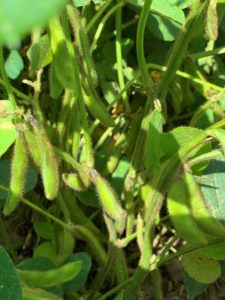
Figure 7: Soybean at Full Seed
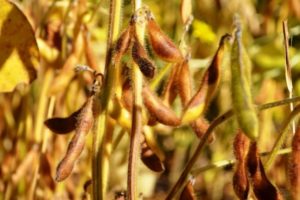
Seed Shape & Size
Soybean seeds come in a wide variety of sizes and hull colours such as black, brown, yellow, and green. Bicoloured seeds and variegated (seeds that are edged or patterned in a second colour) and are also common. The hull of the mature bean is hard, water-resistant, and protects the cotyledon and hypocotyl (or “germ”) from damage. If the seed coat is cracked, the seed will not germinate. The scar, visible on the seed coat, is called the hilum (colours include black, brown, buff (a light brownish yellow color), grey and yellow) and at one end of the hilum is the micropyle, or small opening in the seed coat which can allow the absorption of water for sprouting.
Adaptation Characteristics
Optimal Temperature |
|
Frost & Drought Tolerance |
|
Type |
|
Varieties |
|
Maturity/Dates |
|
Soil |
|
Stages of Development
The life cycle of the soybean plant has four principal stages:
- germination and emergence
- vegetative stage
- reproductive stage
- senescence (mature stage)
Resources
History
The domestication of soybean took place in the eastern half of China as early as the 11th Century BC where they were cultivated into a food crop. From China, it was introduced into Korea and Japan, probably after 200 BC, and has since spread widely throughout Asia. From about the 15th to 16th Century, soybeans were introduced into several countries such as Japan, Indonesia, the Philippines, Vietnam, Thailand, Malaysia, Burma, Nepal and India. The spread of the soybean was due to the establishment of sea and land trade routes. The earliest Japanese reference to the soybean is in the classic Kojiki (Records of Ancient Matters) which was completed in 712 AD. (History of Soybeans)
Europeans became aware of soybean around the late 17th Century, and movement of the crop into the United States took place in 1765 by Samuel Bowen, who sent seeds from Georgia to the American Philosophical Society in Philadelphia for Testing. (Soy Info Center) . During the 20th Century, soybean was subject to major development in the U.S., resulting in the crop becoming dominant in world oilseed trade. Other countries, including Australia, Brazil and Argentina, have adopted soybean varieties directly from the United States.
Special thanks to Saskatchewan Pulse Growers and Manitoba Pulse & Soybean Growers.
